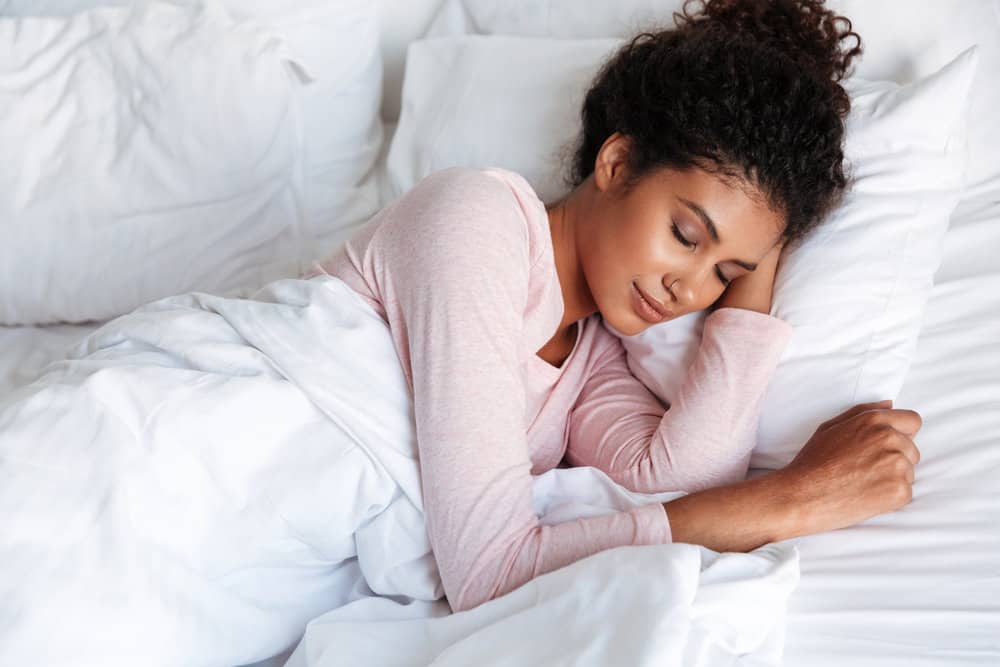
From head colds to stubborn knots and tangles, we’ve all heard warnings about the dangers of going to bed with wet hair. Luckily, there is a way for curly girls to go to sleep with wet hair without taking on a ton of risk.
If you’re looking for tips on how you can keep your bouncy curls healthy and looking great overnight, we have great news!
This article will walk you through how to sleep with wet curly hair without ruining it.
We’ll also take a look at some of the advantages and disadvantages of sleeping with wet curls, so make sure you keep reading until the end!
Table of Contents
Here’s How to Sleep With Wet Curly Hair
As promised, here are a few ways to safely sleep with wet curly hair. You can use each of these methods as is or use a combination of techniques to get even better results.

Prepare Your Hair Beforehand
Sleeping with wet hair can be damaging, so minimize risk by making sure your strands are prepared. Apply your favorite moisturizing products and work out any existing knots and tangles.
Then, seal in moisture with a hair-healthy oil.
Keep in mind that you never want to go to bed with sopping wet hair. Instead, make sure that your strands are about 70% dry before you head off to sleep.

Switch to a Satin Pillowcase
Sleeping with your hair uncovered can reduce the risks of sleeping with wet hair and increase the chances of your hair being dry when you wake up.
However, cotton pillowcases suck moisture from your strands and chip away at your hair’s structural integrity. Switching to a silk or satin pillowcase can prevent this and help keep your curls safe.
Unlike cotton pillowcases, your hair will glide over the smooth satin fabric without creating frizz and tangles.
Just make sure you wash your pillowcase shortly after going to sleep with damp hair. The wet material can hold onto moisture and harbor potentially dangerous bacteria and fungi.
Note: Some women prefer wearing a silk or satin bonnet with wet or dry hair instead of using a satin or silk pillowcase. The goal is to help prevent hair breakage, dryness, and more while protecting your curls overnight.

Try the Pineapple Method
If you have curly hair, you’re probably already familiar with the pineapple method. It's a curly girl staple because it keeps your natural curls looking lush, defined, and fluffy.
First, apply your favorite leave-in or hair moisturizer to your hair.
Then, bend forward and pile all your curls onto the top of your head. Make a ponytail and secure it with a large scrunchy or hair tie. Secure everything with a satin or silk scarf, and that’s it!
And don’t worry if your hair isn’t long enough to pull into a pineapple; you can still give this method a try! Just pull your hair into two or three mini-pineapples on the top and sides of your head.
When you’re ready to take down your pineapple, remove the scarf and use your fingers to fluff and style your hair. You can also use an afro pick or wide tooth comb, although that may shorten the lifespan of your hairstyle.

Throw Your Hair Into a Braid or Twist
Braids and twists keep your strands together, which helps keep your hair from getting tangled and creating knots. The more kept together and secure your hair is when you sleep, the less it will rub against itself or your bedding.
As a bonus, you’ll also be left with a super cute style once you take out your braids or twists. Keep in mind that the smaller and tighter your braids are, the more defined your hairstyle will turn out.
Braid-outs and twist-outs are quickly ruined by frizz, so ensure your hair dries completely before you take them down.

How To Refresh Curly Hair After Sleeping On It
After a long night's sleep, you might wake up to find that your curls look a little stiff, smashed, or tangled. They may need a little more help getting back to their former glory.
To start, take down your hair and shake your head slightly to loosen up your curls.
Fill a spray bottle with warm water and a few drops of leave-in conditioner, and spritz your strands. Focus on the ends and middles of your hair rather than your roots or scalp.
Rake your hands through your curls to smooth them and encourage clumping.
Rub a dollop of curl-enhancing product between your palms and smooth it over your hair. Fluff your hair with your fingers, and allow your hair to air dry.
If you’re in a rush, you can speed the drying process up with a blow dryer diffuser. Once your hair is dry, you’re ready to start your day with some big, bouncy, voluminous curls!

Pros and Cons of Sleeping with Wet Curly Hair
Now that you know how to sleep with wet, curly hair, we’d like to look at some of the risks and benefits. Use the information we’ll cover in this section to help you decide if going to bed with wet curls is right for you.
Pros
- It can save you time - The main benefit of going to bed with wet hair is that it saves you time. You won’t have to wait for your hair to air dry or spend time blow drying your locks. Instead, you can just go straight to sleep and let your hair dry overnight.
- You can get a head start on styling your hair - Sleeping with damp hair also allows you to style your hair passively. Putting your hair in roller sets, braid outs, or pin curls can give you a head start on the following morning’s hairdo.
- You can avoid heat damage - Going to sleep with wet hair means you can skip the blow dryer and air dry your hair overnight instead. That keeps your strands safe from heat damage and enables you to keep hot tool styling to a minimum.

Cons
- Sleeping with wet hair can be uncomfortable - Many people find sleeping with wet hair to be uncomfortable. Damp hair makes it difficult to get warm and cozy, and you may notice cold water dripping down your neck or back. Additionally, the water from your hair can soak into your pillow or blankets.
- It encourages bacterial and fungal growth - When you sleep with wet hair, your warm, damp scalp creates the perfect conditions for fungal and bacterial growth. That can lead to uncomfortable scalp issues like redness, irritation, dryness, and dandruff. Remember, this isn’t limited to your scalp. As the water soaks into your pillow and blankets, they may begin to support bacterial and fungal growth as well.
- You might suffer from breakage - Hair is incredibly fragile when wet, so sleeping with damp hair may lead to breakage and hair loss. Curly hair (i.e., textured hair) is already weaker than wavy and straight hair strands, which means it’s more likely to experience severe breakage overnight.
- You may wake up with more tangles - One of the worst things about going to sleep with wet hair is that you’re more likely to wake up with knots and tangles. When your hair is damp, your cuticle opens and becomes more jagged. As the strands rub up against each other, they snag and get caught.
- Hair Is Curly When Wet
- What Does Damaged Hair Look Like Wet?
- Is It Good to Wet Your Hair Everyday?
- Why Does My Hair Stick Together?
Sleeping with wet hair is risky, so you should avoid it whenever possible. If you do ever have to sleep with damp hair, just make sure you follow the tips we’ve suggested in this article.
That way, you can avoid some of the risks and enjoy all of the benefits!
We hope that we were able to answer all of your questions about sleeping with wet hair, and we wish you the best of luck in your natural hair care journey.




